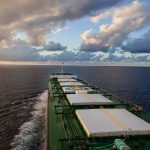If you only look at Los Angeles and Long Beach — the largest container import gateway in America — you’d think shipping congestion has drastically reduced. The number of ships waiting there has fallen to 26 from a high of 109 in January. But in fact, North American port congestion has just re-entered record territory. The offshore traffic jam is once again as bad as it’s ever been.
In January and February, when North American congestion previously peaked, there were just under 150 container vessels waiting off the coastlines. Two-thirds were in the Los Angeles/Long Beach queue.
As of Thursday morning, there were 153, the majority off East and Gulf Coast ports. Whereas the earlier West Coast pileup was centralized, highly publicized and relatively easy to track, today’s ship queue is more widely disbursed and attracting less attention.
Ship queues bounce back
Port congestion had finally looked like it was easing in May and early June. Ship queues had fallen back to double digits. There were 92 vessels waiting offshore as of June 10, led by 25 off Savannah, Georgia, 20 off Los Angeles/Long Beach, 18 off New York/New Jersey and 14 off Houston.
Then things turned for the worse. The tally rose to 125 on July 8, 136 on July 13 and 140 on July 19.
With the count now rising to 153, the North American container ship queue has increased in size by 66% over the past seven weeks.
As of Thursday morning, ship-position data from MarineTraffic and the latest queue lists for California ports showed 43 container ships waiting off Savannah; 26 off Los Angeles/Long Beach; 24 off Houston; 18 off New York/New Jersey; 17 off Vancouver, British Columbia; 15 off Oakland, California; and 10 ships off other ports.
Of those, 59 ships – 38% of the total – were waiting off the West Coast, where queues have climbed off Vancouver and Oakland. There were 94 ships (62% of the total) off the East and Gulf Coast ports, with counts up in both Savannah and Houston.
Different terminals, different waiting time
U.K.-based data provider VesselsValue found large differences in the waiting times at the top 10 East Coast terminals, including major differences between terminals in the same port complex.
It cited four East Coast terminals with long wait times: the New York and Elizabeth APM terminals in the Port of New York/New Jersey and the Garden City and Savannah terminals in the Port of Savannah.
In contrast, VesselsValue data found relatively short wait times at the Maher and Port Newark terminals in New York/New Jersey; the Norfolk International and Virginia International Gateway terminals in Norfolk, Virginia; the Packer Avenue terminal in Philadelphia; and the Wando Welch terminal in Charleston, South Carolina.
Shift caused by port labor fears?
It may be no coincidence that East and Gulf Coast congestion ramped up starting in June. That was the month new annual contracts kicked in. It was also the last month before the West Coast labor contract with the ILWU longshoreman union expired.
Akhil Nair, vice president of carrier management at Seko Logistics, said during a briefing on July 20, “With all the early threats of the potential ILWU strike and labor constraints on the West Coast, there was an automatic shift during contract season for customers to actually require traditional West Coast shippers to request allocation on the East Coast as well. This was their contractual hedge that they put in place.
“This has resulted now in people probably having overcompensated. The congestion on the East Coast is a result of some of this shifting in the supply chain design and hedging for potential incidents or reliable or unpredictable activity on the West Coast.”
Source: Hellenic Shipping News





